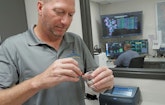
Rochester Public Utilities water distribution crew members work to replace a gate valve as part of the city’s ongoing water distribution system upgrades. Team members include (from left) Maintenance and Construction Manager Douglas Klamerus and lead water distribution workers Rich Rain, Steve Quandt and Nate Blees. (Photography by Brad Stauffer)
The team at Rochester Public Utilities, the city’s water services provider, knows a thing or two about good management. The utility won an award from the Association of Metropolitan Water Agencies for exceptional performance in managing its resources to the benefit of its...








